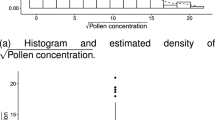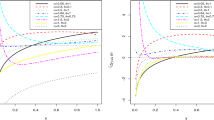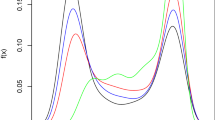Abstract
We motivate this paper by showing through Monte Carlo simulation that ignoring the skewness of the response variable distribution in non-linear regression models may introduce biases on the parameter estimates and/or on the estimation of the associated variability measures. Then, we propose a semiparametric regression model suitable for data set analysis in which the distribution of the response is strictly positive and asymmetric. In this setup, both median and skewness of the response variable distribution are explicitly modeled, the median using a parametric non-linear function and the skewness using a semiparametric function. The proposed model allows for the description of the response using the log-symmetric distribution, which is a generalization of the log-normal distribution and is flexible enough to consider bimodal distributions in special cases as well as distributions having heavier or lighter tails than those of the log-normal one. An iterative estimation process as well as some diagnostic methods are derived. Two data sets previously analyzed under parametric models are reanalyzed using the proposed methodology.







Similar content being viewed by others
References
Akaike H (1973) Information theory and an extension of the maximum likelihood principle. In: Petrov BN, Csaki F (eds) International symposium on information theory. Akademiai Kiado Budapest, Hungary, pp 267–281
Andrews DR, Mallows CL (1974) Scale mixtures of normal distributions. J R Stat Soc Ser B 36:99–102
Barndoff-Nielsen O (1977) Exponentially decreasing distributions for the logarithm of particle size. Proc R Soc Lond A Math 353:401–419
Birnbaum ZW, Saunders SC (1969) A new family of life distributions. J Appl Probab 6:319–327
Box GEP, Tiao GC (1973) Bayesian inference in statistical analysis. Addison-Wesley, USA
Cancho VG, Lachos VH, Ortega EMM (2010) A nonlinear regression model with skew-normal errors. Stat Pap 51:547–558
Conover WJ (1971) Practical nonparametric statistics. Wiley, New York
Cook RD (1986) Assessment local influence (with discussion). J R Stat Soc Ser B 48:133–169
Cysneiros FJA, Paula GA, Galea M (2007) Heteroscedastic symmetrical linear models. Stat Prob lett 77:1084–1090
Cysneiros FJA, Vanegas LH (2008) Residuals and their statistical properties in symmetrical nonlinear models. Stat Prob lett 78:3269–3273
Cysneiros FJA, Cordeiro GM, Cysneiros AHMA (2010) Corrected maximum likelihood estimators in heteroscedastic symmetric nonlinear models. J Stat Comput Simul 80:451–461
Diaz-Garcia JA, Leiva V (2005) A new family of life distributions based on elliptically contoured distributions. J Stat Plan Inference 128:445–457
Dempster AP, Laird NM, Rubin DB (1977) Maximum likelihood from incomplete data via the EM algorithm. J R Stat Soc Ser B 39:1–38
Fang KT, Kotz S, Ng KW (1990) Symmetric multivariate and related distributions. Chapman and Hall, London
Galea M, Paula GA, Cysneiros FJA (2005) On diagnostic in symmetrical nonlinear models. Stat Prob lett 73:459–467
Green PJ, Silverman BW (1994) Nonparametric regression and generalized linear models. Chapman and Hall, Boca Raton
Groeneveld RA, Meeden G (1984) Measuring skewness and kurtosis. Statistician 33:391–399
Hastie TJ, Tibshirani RJ (1990) Generalized additive models. Chapman and Hall, London
Ibacache-Pulgar G, Paula GA, Cysneiros FJA (2013) Semiparametric additive models under symmetric distributions. Test 22:103–121
Labra FV, Garay AM, Lachos VH, Ortega EMM (2012) Estimation and diagnostics for heteroscedastic nonlinear regression models based on scale mixtures of skew-normal distributions. J Stat Plan Inference 142:2149–2165
Lachos VH, Bandyopadhyay D, Garay AM (2011) Heteroscedastic nonlinear regression models based on scale mixtures of skew-normal distributions. Stat Prob lett 81:1208–1217
Lange KL, Little RJ, Taylor J (1989) Robust statistical modelling using the \(t\)-distribution. J Am Stat Assoc 84:881–896
Lemonte AJ, Cordeiro GM (2009) Birnbaum–Saunders nonlinear regression models. Comput Stat Data Anal 53:4441–4452
Leiva V, Riquelme M, Balakrishnan N, Sanhueza A (2008) Lifetime analysis based on the generalized Birnbaum–Saunders distribution. Comput Stat Data Anal 52:2079–2097
Li AP, Chen ZX, Xie FC (2012) Diagnostics analysis for heterogeneous log-Birnbaum–Saunders regression models. Stat Prob lett 82:1690–1698
Lin JG, Xie FC, Wei BC (2009) Statistical diagnostics for skew-\(t\)-normal nonlinear models. Commun Stat Simul Comput 38:2096–2110
Lucas A (1997) Robustness of the Student-\(t\) based M-estimator. Commun Stat Theory Methods 26:1165–1182
Paula GA, Leiva V, Barros M, Liu S (2012) Robust statistical modeling using the Birnbaum–Saunders-\(t\) distribution applied to insurance distribution. Appl Stoch Models Bus Ind 28:16–34
Poon WY, Poon YS (1999) Conformal normal curvature and assessment of local influence. J R Stat Soc Ser B 61:51–61
Rieck JR, Nedelman JR (1991) A log-linear model for the Birnbaum–Saunders distribution. Technometrics 33:51–60
Rigby RA, Stasinopoulos DM (2005) Generalized additive models for location, scale and shape. J Appl Stat 54:507–554
Rigby RA, Stasinopoulos DM (2006) Using the Box-cox \(t\) distribution in GAMLSS to model skewness and kurtosis. Stat Model 6:209–229
Rigby RA, Stasinopoulos DM (2007) Generalized additive models for location, scale and shape (GAMLSS) in R. J Stat Softw 23:1–46
Rogers WH, Tukey JW (1972) Understanding some long-tailed symmetrical distributions. Stat Neerl 26:211–226
Vanegas LH, Paula GA (2014) ssym: Fitting semiparametric symmetric regression models. R package version 1.5. http://CRAN.R-project.org/package=ssym
Villegas C, Paula GA, Cysneiros FJA, Galea M (2013) Influence diagnostics in generalized symmetric linear models. Comput Stat Data Anal 59:161–170
West M (1987) On scale mixtures of normal distributions. Biometrika 74:646–648
Wood SN (2006) Generalized additive models: an introduction with R. Chapman and Hall, Boca Raton
Acknowledgments
The authors are grateful to the editors and two anonymous referees for useful comments and suggestions. This research project was partially supported by CNPq, FAPESP and CAPES, Brazil.
Author information
Authors and Affiliations
Corresponding author
Appendices
Appendix A. Log-symmetric distributions
The absolutely continuous and positive random variable \(T\) follows log-symmetric distribution with density generator \(g(\cdot )\), scale parameter \(\eta \) and power parameter \(\phi \) if its density function can be written as
where \(\tilde{t}=\log \left[ \!\left( {t}/{\eta }\right) ^{\frac{1}{\sqrt{\phi }}}\!\right] \), \(\eta > 0\), \(\phi >0\), and \(g(u)>0\) for \(u>0\) and \(\int _{0}^{\infty }\!\!\!u^{\!-\!\frac{1}{2}}\!g(u)\partial u=1\). If this condition is satisfied then it is written \(T\sim {\mathcal {LS}}(\eta ,\phi ,g(\cdot ))\). For example, using \(g(u)\propto \exp (-u/2)\), \(g(u)\propto (1+\frac{u}{\nu })^{-\frac{\nu +1}{2}}\), \(g(u)\propto \exp [-\frac{1}{2}u^{\frac{1}{1+\varrho }}]\), \(g(u)\propto \exp [-\varsigma \sqrt{1+u}]\), \(g(u)\propto \mathrm{IGF}\left( \iota + \frac{1}{2},\frac{u}{2}\right) \), \(g(u)\propto \mathrm{cosh}({u}^{\frac{1}{2}})\exp [-\frac{2}{\alpha ^2}\,\mathrm{sinh}^2({u}^{\frac{1}{2}})]\) (for \(\phi =4\)) and \(g(u)\propto \mathrm{cosh}({u}^{\frac{1}{2}})\times [1 + 4\,\mathrm{sinh}^2({u}^{\frac{1}{2}})/\nu \alpha ^2]^{-\frac{\nu +1}{2}}\) (for \(\phi =4\)) as density generator one obtains a random variable \(T\) following log-normal, log-Student-\(t\) (having \(\nu >0\) degrees of freedom), log-power-exponential (having shape parameter \(-1<\varrho <1\)), log-hyperbolic (having shape parameter \(\varsigma >0\)), log-slash (having shape parameter \(\iota >0\)), Birnbaum–Saunders (having shape parameter \(\alpha >0\)) and Birnbaum–Saunders-\(t\) (having shape parameter \(\alpha >0\) and \(\nu >0\) degrees of freedom) distributions, respectively, in which \(\mathrm{IGF}(a,x)=\frac{1}{x^a}\int \nolimits _{0}^{x}\exp (-t)t^{a-1}\partial t\) for \(a>0\) and \(x\ge 0\) is the incomplete gamma function. In fact, it is possible to show that the generalized Birnbaum–Saunders distribution (Diaz-Garcia and Leiva 2005; Leiva et al. 2008) belongs to the class of log-symmetric distributions with \(g(u;\alpha ,\bar{\zeta })\propto \bar{g}\left( 4\,\mathrm{sinh}^2({u}^{\frac{1}{2}})/\alpha ^2;\bar{\zeta }\right) \times \mathrm{cosh}({u}^{\frac{1}{2}})\), where \(\phi =4\) and \(\bar{g}(u;\bar{\zeta })\) is the kernel that characterizes the generalized Birnbaum–Saunders distribution.
1.1 Some statistical properties
If \(T\sim {\mathcal {LS}}(\eta ,\phi ,g(\cdot ))\) then it is possible to verify that
-
\(Y=\log (T) \sim {\mathcal S}(\mu ,\phi ,g(\cdot ))\), i.e., the distribution of \(Y\) belongs to the class of symmetric distributions (Fang et al. 1990) having density generator \(g(\cdot )\), location parameter \(\mu =\log (\eta )\) and dispersion parameter \(\phi \).
-
\({c}\,T \sim {\mathcal {LS}}(c\,\eta ,\phi ,g(\cdot ))\) for all constant \(c>0\).
-
\(T^{c}\sim {\mathcal {LS}}(\eta ^c,c^2\,\phi ,g(\cdot ))\) for all constant \(c\ne 0\).
-
The median of \(T\) is \(\eta \).
-
The quantile function of \(T\) is given by \(\vartheta (q)=\eta \,\exp (\sqrt{\phi }\,Z^{(q)})\), where \(Z^{(q)}\) is the \(100(q)\,\%\) quantile of \(Z=({Y-\mu })/{\sqrt{\phi }}\sim \mathcal {S}(0,1,g(\cdot ))\) distribution.
-
The skewness measure proposed by Groeneveld and Meeden (1984) is given by \(\varkappa ^*({q})=[{\vartheta (q)\!+\!\vartheta (1\!-\!q)\!-\!2\vartheta (1/2)}]/[{\vartheta (1\!-\!q)\!-\!\vartheta (q)}]= \mathrm{cosech}\left( \sqrt{\phi }Z^{(q)}\right) -\mathrm{cotanh}\left( \sqrt{\phi }Z^{(q)}\right) \), where \(q \in (0,1/2)\) and \(\mathrm{cotanh}(\cdot )\) and \(\mathrm{cosech}(\cdot )\) are the hyperbolic cotangent and cosecant functions, respectively. It is possible to verify that, for every \(q \in (0,1/2)\) and for fixed \(\zeta \): (i) \(\varkappa ^*({q})>0\), (ii) \(\varkappa ^*({q})\) does not depend on \(\eta \), (iii) higher is the skewness of \(T\) higher is the value of \(\varkappa ({q})\), and (iv) \(\varkappa ^*({q})\) is a monotone increasing function of \(\phi \). As a consequence, the parameter \(\phi \) may be interpreted as the skewness of the \(T\) distribution (for fixed \(\zeta \)), which is always positive.
Appendix B. \({v}(z_k)\), \(d_g(\zeta )\) and \(f_g(\zeta )\) expressions
For example, when it is assumed that \(\xi \) follows log-normal, log-Student-\(t\), log-hyperbolic, log-power-exponential and Birnbaum–Saunders distributions one obtains \({v}(z_k)=1\), \({v}(z_k)=(\nu +1)/(\nu +z^2_k)\), \({v}(z_k)=\varsigma /\sqrt{1+z^2_k}\), \({v}(z_k)=|z_k|^{-\frac{2\varrho }{\varrho +1}}/(1+\varrho )\) and \({v}(z_k)=4\, \mathrm{sinh}(z_k)\mathrm{cosh}(z_k) /\alpha ^2z_k- \mathrm{tanh}(z_k)/z_k\), respectively. Similarly, the quantity \(d_g(\zeta )\) is equal to 1, \((\nu +1)/(\nu +3)\), \(\{2^{1-\varrho }\Gamma [(3-\varrho )/2]\}/\{(1+\varrho )^2\Gamma [(1+\varrho )/2]\}\) and \(2+\frac{4}{\alpha ^2}-\frac{\sqrt{2\pi }}{\alpha }\left\{ 1-\mathrm{erf}\left( \frac{\sqrt{2}}{\alpha }\right) \right\} \mathrm{exp}\left( \frac{2}{\alpha ^2}\right) \) when it is assumed that \(\xi \) follows log-normal, log-Student-\(t\), log-power-exponential and Birnbaum–Saunders distributions, respectively, where \(\Gamma (\cdot )\) represents the gamma function and \(\mathrm{erf}(x)=(2/\sqrt{\pi })\int _0^x e^{-t^2}dt\). Also, the quantity \(f_g(\zeta )\) is equal to 3, \(3(\nu +1)/(\nu +3)\) and \((\varrho +3)/(\varrho +1)\) when \(\xi \) follows log-normal, log-Student-\(t\) and log-power-exponential distributions, respectively.
Appendix C. Expressions of \(d_k(\hat{\varvec{\mu }}|\hat{\varvec{\phi }})\) and \(d_k(\hat{\varvec{\phi }}|\hat{\varvec{\mu }})\)
We list in the Tables 5 and 6 the expressions of the individual contribution to the deviances for some log-symmetric distributions.
Appendix D. Observed information matrix of \(\varvec{\theta }\)
The observed information matrix of \(\varvec{\theta }\) becomes \(-\ddot{\mathbf{L}}_{_{\theta \theta }}\), where
with
in which \(\mathbf{D}_{_{\beta \beta }}^{(k)}\!\!=\!\!\Bigl [{\partial ^2\mu _k}/{\partial \beta _i\partial \beta _j}\Bigr ]\) for \(i,j=1,\ldots ,p\), \(\mathbf{D}_{(a)}\!=\!\mathrm{diag}\{\mathrm{a}_1,\ldots ,{a}_n\}\), \(\mathbf{D}_{(h)}\!=\!\mathrm{diag}\{\mathrm{h}_1,\ldots ,{h}_n\}\) and \(\mathbf{D}_{(c)}\!=\!\mathrm{diag}\{\mathrm{c}_1,\ldots ,{c}_n\}\), being \({a}_k\!=\!{v}_k'z_k\! +\! {v}_k\) (\({v}_k'\) is the first derivative of \({v}_k\) regarding \(z_k\)), \({h}_k\!=\! z_k({{v}_k'z_k}\!+\!{2\mathrm{v}_k})/2\) and \({c}_k=z_k {h}_k/2\).
Rights and permissions
About this article
Cite this article
Vanegas , L.H., Paula, G.A. A semiparametric approach for joint modeling of median and skewness. TEST 24, 110–135 (2015). https://doi.org/10.1007/s11749-014-0401-7
Received:
Accepted:
Published:
Issue Date:
DOI: https://doi.org/10.1007/s11749-014-0401-7
Keywords
- Skewness
- Asymmetric responses
- Maximum penalized likelihood estimates
- Semiparametric models
- Robust estimates
- Natural cubic spline




